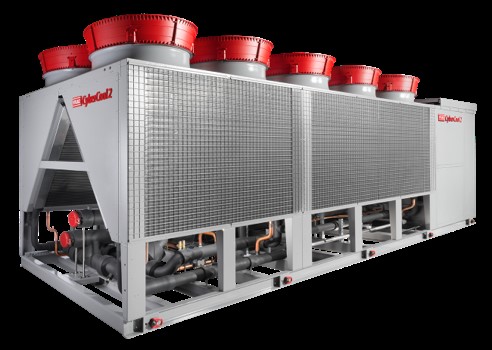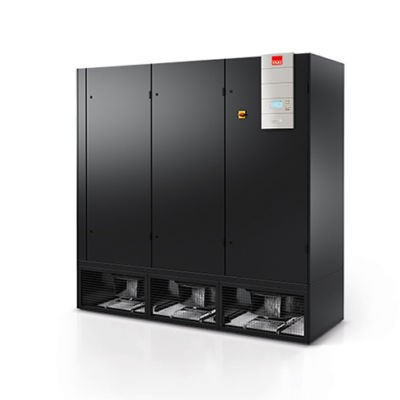[Use case] Expansion of a data center in Eindhoven
News | 09.08.2023
In collaboration with Interconnect and other subcontractors, STULZ has realized the cooling for the expansion of Interconnect’s data center in Eindhoven. .
Interconnect — is a Data & Cloud Centre and the largest independent provider in the south of the Netherlands. Since 1995, they have been supporting organisations with various IT solutions from 's-Hertogenbosch and Eindhoven.
STULZ was jointly responsible for engineering, supplying, assembling and installing six STULZ CyberCool 2 chillers and various STULZ CyberAir 3 units in the various data center rooms. In addition, STULZ developed a custom-made solution by placing six containers in which, among other things, the adiabatic cooling is housed. The biggest challenge for this project was the complexity of the installation as a whole. Interconnect's wishes were clear: nine server rooms made up of three different cooling capacities, 400 kW, 800 kW and 1000 kW. The challenge here, was the uncertainty of the distribution of the server capacity in each server room. Ultimately it was decided to adapt the infrastructure in such a way that on the top two floors both the 1000 kW rooms and the 400 kW rooms could be realized if possible. Initially, they wanted to realize a higher cooling capacity in the data center, unfortunately this was not possible due to constructive limitations. The limiting factor in this matter was the limited height of the floor itself. It is very important that a data center is operational at any time, regarding cooling but also regarding electricity, because without electricity, cooling is not possible at all. Therefore back-up systems are very important. A data center must also operate as energy-efficient as possible, with the Return On Investment (ROI) being as high as possible.
STULZ SOLUTION
To meet the above stated requirements, a total of six CyberCool 2 chillers from STULZ, each with a cooling capacity of 1200 kW, were chosen to place on the roof of the data center. In the server rooms, it was decided to use one type of STULZ unit (the CyberAir 3) in order to increase efficiency. In the 400 kW server rooms, the STULZ CyberAir 3 units provide a cooling capacity of 200 kW per unit, in the 800 kW and 1000 kW server rooms they deliver less than 200 kW per unit, however, more units will be installed to meet the requirements. The CyberCool 2 chillers are all six equipped with the most energy-efficient components, including the option of Free Cooling mode. It is almost impossible to develop a more complete cooling unit.
CyberCool 2 & CyberAir 3 are the most energy efficient solutions in comparison with competitive solutions on the market. This translates into a visibly lower energy consumption. The ROI is high and the units ultimately pay for themselves completely. The total cooling installation contains three water-separated cooling systems, one of which can fail completely (the installations consist of N + 1). This means that, for example in a 400 kW room, three STULZ CyberAir 3 units have been installed, each with a cooling capacity of 200 kW. This results in a total cooling capacity of 600 kW and each STULZ unit gets its cooling water from a different cooling system. If one STULZ unit should fail, the required cooling capacity will be realized by the other two STULZ units. The same situation has been realized on the roof of the data center. Two chillers are connected to each cooling system and if even two chillers fail (whichever one), the cooling is still guaranteed in the entire data center.
The unique factor in the project is the choice to place six custom-made (sea) containers on the roof of the data center. Various components are housed in these six containers, including the buffer tanks, but also the adiabatic cooling of CAREL (ChillBooster units). An advantage of adiabatic cooling is that the cooling capacity increases when the outside temperature rises, while this decreases with traditional compressor cooling. It cools the air before it reaches the chiller. For example, 100 litres of water supplies approximately 69 kW of cooling with only 0.25 kW of power absorbed by the pump. This ensures that energy consumption is reduced on the hottest days of the year. In addition, water as a refrigerant is completely environmentally friendly in contrast to traditional refrigerants.
Besides that, cost efficiency played a major role in the decision to place a part of the installation in six separate containers. In addition, a significant advantage was that the installations are better protected against, among other things, weather influences. By placing LED lighting in the containers, the service engineers can easily perform their work at any time of the day, including during the (dark) night hours. This cooling installation is also equipped with the option of transferring the heat produced in the server rooms to, for example, a heat network in the future.

CyberCool 2 The CyberCool 2 enables you to operate with maximum energy efficiency and optimum reliability for complex, demanding and uncompromising chilled water solutions. At the same time, the completely new overall concept of all components ensures low sound emissions in noise-critical applications. The result is a sustainable range of chillers that meets every eco-design directive.

CyberAir 3 The CyberAir 3PRO room air conditioner is the result of more than three decades of experience with projects around the world, and is the logical next step in the development of the successful CyberAir 3 series. To achieve maximum cooling capacity with a minimal footprint while promising you maximum potential savings, these HVAC system units are more adaptable than any other precision air conditioning unit on the market.








